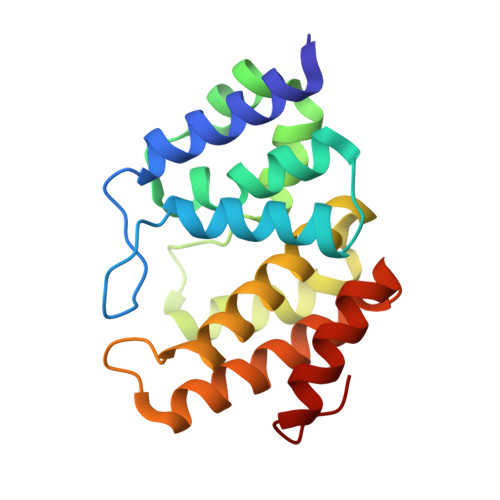A metazoan ortholog of SpoT hydrolyzes ppGpp and functions in starvation responses
Sun, D.W., Lee, G., Lee, J.H., Kim, H.Y., Rhee, H.W., Park, S.Y., Kim, K.J., Kim, Y., Kim, B.Y., Hong, J.I., Park, C., Choy, H.E., Kim, J.H., Jeon, Y.H., Chung, J.(2010) Nat Struct Mol Biol 17: 1188-1194
- PubMed: 20818390
- DOI: https://doi.org/10.1038/nsmb.1906
- Primary Citation of Related Structures:
3NQW, 3NR1 - PubMed Abstract:
In nutrient-starved bacteria, RelA and SpoT proteins have key roles in reducing cell growth and overcoming stresses. Here we identify functional SpoT orthologs in metazoa (named Mesh1, encoded by HDDC3 in human and Q9VAM9 in Drosophila melanogaster) and reveal their structures and functions. Like the bacterial enzyme, Mesh1 proteins contain an active site for ppGpp hydrolysis and a conserved His-Asp-box motif for Mn(2+) binding. Consistent with these structural data, Mesh1 efficiently catalyzes hydrolysis of guanosine 3',5'-diphosphate (ppGpp) both in vitro and in vivo. Mesh1 also suppresses SpoT-deficient lethality and RelA-induced delayed cell growth in bacteria. Notably, deletion of Mesh1 (Q9VAM9) in Drosophila induces retarded body growth and impaired starvation resistance. Microarray analyses reveal that the amino acid-starved Mesh1 null mutant has highly downregulated DNA and protein synthesis-related genes and upregulated stress-responsible genes. These data suggest that metazoan SpoT orthologs have an evolutionarily conserved function in starvation responses.
Organizational Affiliation:
Division of Magnetic Resonance, Korea Basic Science Institute, Chungbuk, South Korea.















